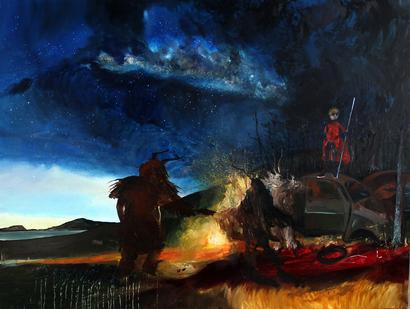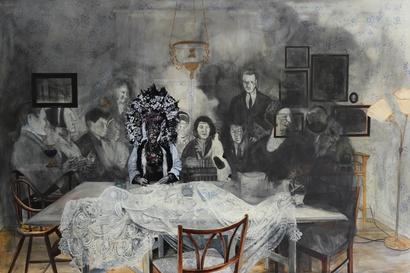Works













I was born and raised in the industrial city of Katowice, in the last years of communist Poland, with extensive art studies in London, now living in a rural area in the heart of Sweden.
I belong to the second-largest ethnic national minority in Poland. In ethnographic literature, Silesians was the name for the indigenous population of Slavic origin using mainly the local dialects of Polish with numerous Germanisms and Czechisms. I am not interested in the national use of ethnic identity as a political tool but in my attempt to understand the complexity of my origin and what means to be frequently treated as a stranger in my own land and as a foreigner in Sweden.
Living on the farm in Dalarna, Sweden surrounded by forest and hills and I’m often inspired by local folklore. My works depict female stories through Nordic and Slavic myths and folk beliefs. I mix elements like goddesses, hybrids, and modern women's self-representation. Despite structural differences, I find properties or behaviors like micro stories that its parts do not have on their own strength or larger meaning, and emerge only when they interact in a wider whole.
In my work, I collect folktales, folk beliefs, and local myths and traditions. Myths have always played a fundamental role in society and some traditional groups consider myths to be true accounts of their remote past. I paint a new copy of an existing image, which I allow to change in a process as I add new layers; creating a hybrid of time, characters, and places, which I can relate to. My work is on the one hand characterized by an idiosyncratic interpenetration of realism and fantasy, a worldly mind, rationality, and clarity of observation, and on the other hand by folly, outlandishness, and fallacy.
Folklore can be perceived as helping to create meaning and coherence in life and providing hope and strength. Drawing on the heritage of ancient folklore and magic in figurative painting I use old stories to create new visual lexicons.
My work combines the cosmological thinking, complex mythologies, and spiritual vocabularies with my own imagined worlds. I synthesise them into stories that are both futuristic and archaic. Mixing cultural or historical features in my stories, I use the ordinary to depict the epic, the universal, and the transient, in a search for worlds beyond my own.
Through a transdisciplinary approach, my work critiques understandings of nature, gender, and sexuality that attempt to objectify and naturalize women. These norms are justified through evolutionary narratives exclusively permitting male gaze. Everything that does not fit this norm is considered provocative, “erotic”, or promiscuous. These norms have proven detrimental to women. Women have been and still are discriminated against in today's life due to unrealistic beauty standards, age, deeply engrained beliefs and societal values pertaining to women's sexuality, violating their sexual and reproductive health, and rights. My work explores female perspective, sexual expression and the objectification of woman, bodily autonomy, themes of pleasure, love and desire in the context of female sexuality and myths.
